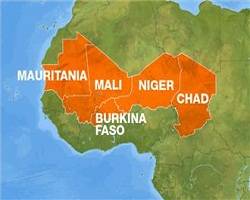Millions of people in up to five West African countries will face a food crisis in early 2012 if early warning systems are ignored, the United Nations and aid officials say.
The UN's Food and Agriculture Organization (FAO), together with the World Food Programme (WFP) and British charity Oxfam, said this week that failed harvests and low food reserves in the Sahel, and particularly the countries of Chad, Mauritania, Burkina Faso and Mali, would affect up to 11 million people.
Oxfam told Al Jazeera on Thursday that protective measures need to be installed as a matter of urgency.
Early estimates indicate that six million people in Niger and 2.9 million people in Mali are vulnerable; while up to a quarter of Mauritania’s population – about 700,000 people - are reported to be at risk of severe food insecurity. In Chad, 13 out of 22 regions are expected to be affected adversely.
According to estimates, the "lean season", when food availability is at its lowest, is likely to start two to four months earlier than normal, while in parts of Mauritania as early as January.
"Pastoralist [herder] farmers will certainly be hard hit, but there will be strong impacts beyond this group too," Stephen Cockburn, Regional campaigns and policy manager at Oxfam, said.
"Among these, women, small livestock holders, poor households with limited access to productive means, households who used to rely on seasonal migration in conflict-affected areas and communities living in areas affected by insecurity are likely to be the most affected.
"High food prices - up to 40 per cent higher than the five-year average - will have a more general impact across the region."
Early warning systems indicate that estimates for the 2011 harvest point to a dramatic decrease in cereal production in the Sahel, estimated at 25 per cent. But erratic rains and extended dry periods are expected to exacerbate lower production and lead to higher food prices.
‘Exaggerations’
However, Seif Sow, regional representative of Famine Early Warning Systems Network (FEWS NET), a USAID-funded organization that monitors food security issues, including strengthening early warning systems, told Al Jazeera the warnings of an impending crisis in the region "are exaggerated".
"Crop failures are localized, meaning that some parts of the countries are affected. But in other parts, there has been decent rainfall and so it’s a mixed situation. The overall production is average.
"They have exaggerated the numbers and the scope of the problem. Response has already started, herders are moving and countries are stocking up. They need to take into account that people have coping strategies, and yes, there has been a decrease in production, but it is not a catastrophe," Sow said.
"If nothing is done, then yes it could be a crisis, but people are acting, through protective programmes and people are developing survival mechanisms … This is not a war situation. A one year food deficit will not translate into famine.”
However, Cockburn said the fact that herders are already moving as a means of surviving, illustrates that serious problems are likely if protective action is not taken. He added that the figures used by Oxfam are widely accepted figures "taken directly from national warning systems and validated by the CILSS".
"We should remember too that this region is chronically vulnerable to food crises - major crises were felt here in 2005, 2008 and 2010 - and even in a 'normal' year, 300,000 children die of malnutrition-related causes.
"When you start from this base, even moderate shocks can have huge impacts on the most vulnerable - and the shocks experienced this year are significant. Levels of global acute malnutrition in the Sahel region are consistently above what UNICEF recognizes as emergency levels, even outside 'crisis years'."
Famine in East Africa
In 2011, scores lost their lives in the Horn of Africa after a devastating drought ravaged southern and central Somalia, northeastern Kenya and parts of Ethiopia. Around 12 million people were affected, with hundreds of thousands fleeing from Somalia into Dolo Ado in Ethiopia and Dadaab in Kenya, as drought-affected regions became unlivable famine zones.
The UN said that up to $2bn were required to address the crisis that had spiraled out of control in a region ravaged by poor governance, lack of infrastructure and continued war.
Meanwhile, the FEWS Network confirmed that famine "will persist" in at least two areas in Somalia, while in the areas of Bay, Bakool and lower Shabelle, substantial humanitarian assistance has mitigated extreme food shortages and mortality levels.
Cockburn said that while the context in the Sahel and West African countries is different, the most important similarity between the two regions lay in the fact that both regions are chronically vulnerable to food shortages, usually exacerbated by recurrent shocks like drought.
A communiqué released by the Food Crisis Prevention Network (FCPN) on December 10 recommended that averting a crisis would require greater attention to the market, as to ensure that prices of essential food items are not raised in deficit zones. The FCPN said that prices were abnormally high already and keeping these prices in check will be necessary to avert a crisis.
Cockburn said "The positive thing in West Africa now is that every government most affected by the crisis [Mali, Mauritania, Niger, Chad, and Burkina Faso] has publicly recognized the severity of the coming crisis, and most have either developed or are developing emergency response plans.
"There is in general a degree of responsiveness that provides the political space to act, and must be built on to ensure all countries develop plans that are supported also by outside actors." .
PHOTO CAPTION
Map locating West African countries
Al-Jazeera


 Home
Home Discover Islam
Discover Islam Quran Recitations
Quran Recitations Lectures
Lectures
 Fatwa
Fatwa Articles
Articles Fiqh
Fiqh E-Books
E-Books Boys & Girls
Boys & Girls  Women
Women










